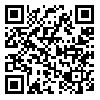Volume 25, Issue 2 (Summer 2021)
jwss 2021, 25(2): 151-174 |
Back to browse issues page
Download citation:
BibTeX | RIS | EndNote | Medlars | ProCite | Reference Manager | RefWorks
Send citation to:



BibTeX | RIS | EndNote | Medlars | ProCite | Reference Manager | RefWorks
Send citation to:
Shirani K. Gully Erosion Mapping and Susceptibility Assessment Using Statistical and Probabilistic Methods. jwss 2021; 25 (2) :151-174
URL: http://jstnar.iut.ac.ir/article-1-4028-en.html
URL: http://jstnar.iut.ac.ir/article-1-4028-en.html
1. Soil Conservation and Watershed Management Research Department, Isfahan Agricultural and Natural Resources, Research and Education Center, AREEO, Isfahan, Iran. , kouroshshirani@gmail.com
Abstract: (4879 Views)
Delineation of gully erosion susceptible areas by using statistical models, as well as optimum usage of existing data and information with the least time and cost and more precision, is important. The main objective of this study is to determine the areas accuracy to gully erosion and susceptibility mapping by using data mining of the bivariate Dempster-Shafer, linear multivariate statistical methods and their integration in Semirom watershed, southern Isfahan province. First, the geographical location of a total of 156 randomly gullies were mapped using preliminary reports, satellite imagery interpretation and field survey. In the next step, 14 conditioning parameters of the gullies in the study area were selected including the topographic, geomorphometric, environmental, and hydrologic parameters using the regional environmental characteristics and the multicollinearity test for modeling. Then, the Dempster-Shafer statistical, linear regression, and ensembled methods were developed using 70% of the identified gullies and 14 effective parameters as dependent and independent variables, respectively. The remaining 30% of the gully distribution dataset were used for validation. The results of the multivariate regression model showed that land use, slope and distance to drainage network parameters have the most significant relation to gully occurrence. The gully erosion susceptibility maps were prepared by individual and ensemble methods and they were divided to 5 classes of very low to very high rate. The area under the curve (AUC) of the receiver operating characteristic (ROC) curve was used to validate gully erosion susceptibly maps. The verification results showed that the AUC of ensemble method (0.948) is higher than Dempster-Shafer (0.924) and Multivariate regression (0.864) methods. Also, the the seed core area index (SCAI) value of the ensembled model from very low to very high susceptible classes have a decreasing trend that indicating a proper separation of susceptible classes by this model.
Keywords: Zonation, Susceptibility, Semirom riffle, Gully, Multivariate regression, Dempster-Shafer, Uncertainty
| Rights and permissions | |
 |
This work is licensed under a Creative Commons Attribution-NonCommercial 4.0 International License. |






